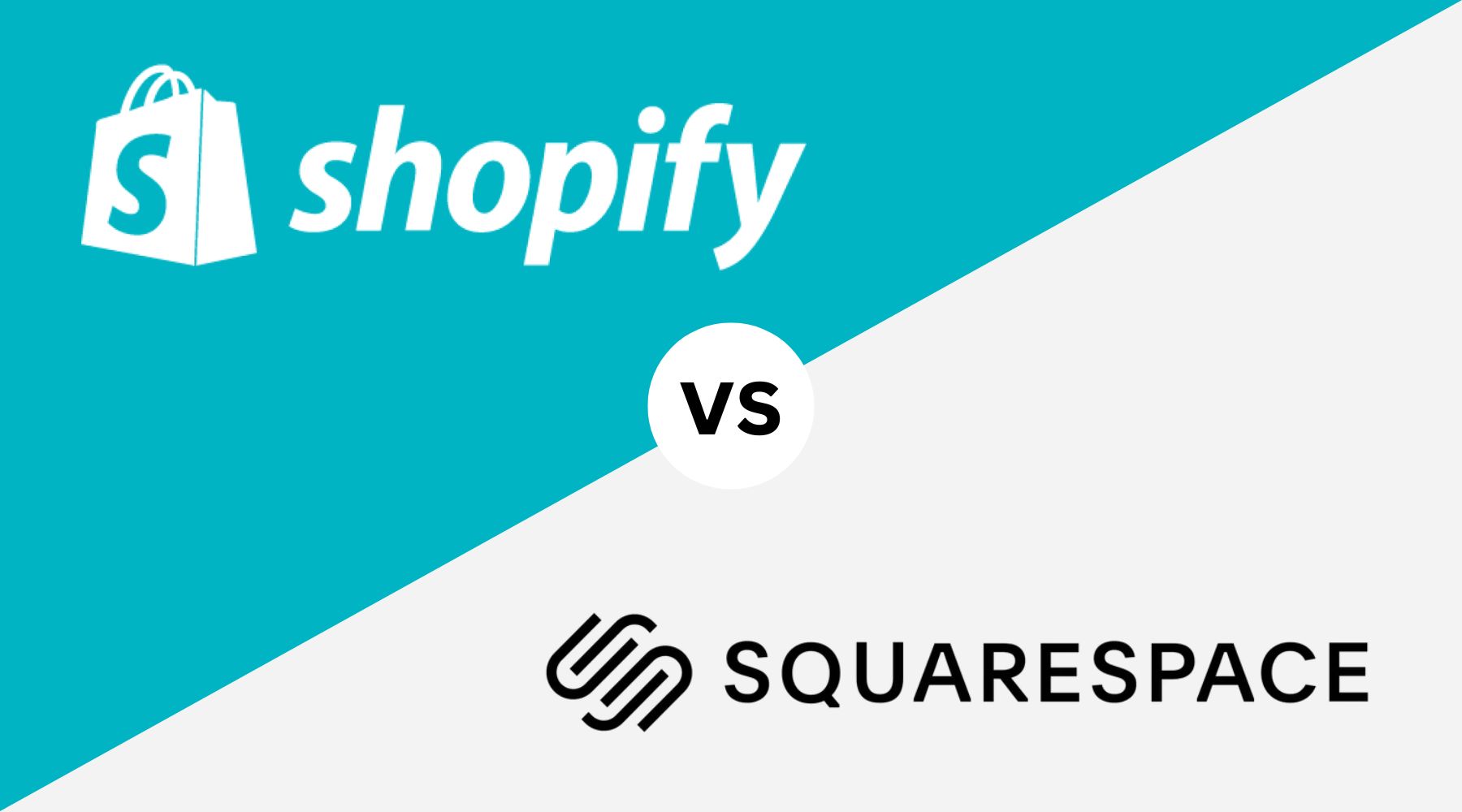Whether you’re a creative solopreneur, a creator brand, or a growing e-commerce business, choosing the right platform has a major impact on your success. Two of the most well-known names in the market are Squarespace and Shopify. But which solution fits your goals better?
In this comprehensive comparison, we analyze all key factors—from design flexibility and e-commerce capabilities to pricing, scalability, and audience fit.
We’ll also show how Shopify vs. Squarespace differs in terms of SEO, template design, marketing tools, and support—data-driven, direct, and practical.
If you’re currently deciding between the two, this article gives you all relevant facts in a clearly structured format, with concrete examples and actionable recommendations for your project.
Because whether you want to build an online store or prefer a visually strong online presence with an integrated shop: the differences between these two e-commerce platforms are decisive.
Let’s start with a direct overview: who benefits from what—and where the clear strengths of each system lie.
Overview: Shopify or Squarespace—what’s better for which use case?
The decision depends heavily on what you want to achieve with your online platform or online shop.
Squarespace shines primarily for creative projects, portfolio websites, or smaller e-commerce shops where design is the priority and the shop functionality plays more of a supporting role.
Shopify, on the other hand, was built for e-commerce from day one and shows its strengths especially in scalable, performance-driven shops.
Squarespace is ideal for solo entrepreneurs, photographers, artists, or local service providers who want a visually strong presence and don’t need much technical complexity. Shopify is the better choice if your focus is revenue, conversion, and professional online selling.
Especially for D2C brands, creator brands, or growth businesses, Shopify provides the necessary infrastructure—including an app ecosystem, headless options, and integrations with tools like Klaviyo or Meta Ads.
So whether you’re planning a blog with product sales, an international D2C business, or a complex webshop: the right platform depends on your use case and how strongly you prioritize conversion, growth, and customization.
Platform fundamentals: Squarespace as a website builder vs. Shopify as a dedicated e-commerce platform
Squarespace originally started as a website builder designed for designers, creatives, and service providers. Its focus is visual presentation, simple navigation, and fast results—especially for users who want to build a strong brand without diving deep into technical details.
Features like blogging, calendar integrations, or portfolio galleries make it ideal for artists, coaches, or freelancers.
Squarespace’s interface is intentionally minimalist. Users choose from many pre-built Squarespace templates, edit via drag-and-drop, and can create a functional website in just a few hours.
E-commerce is integrated—but it’s not the core feature. It’s well suited for shops with a manageable catalog, limited traffic, and low requirements for marketing integrations.
Shopify, by contrast, has been designed as an e-commerce platform from the start. It’s built to sell digital and physical products efficiently—from small side projects to international wholesale operations.
Every process—checkout, payment processing, inventory management, and customer retention—is geared toward scalability and performance.
The backend gives you deep functionality for catalog management, customer administration, order processing, and the use of external apps.
Especially when combined with a Shopify Plus agency or specialized Shopify developers, a Shopify store can be made highly customized—up to custom features, headless commerce, and performance marketing integrations.
|
feature |
Squarespace |
Shopify |
|
origin |
Website Builder |
E-commerce platform |
|
Main focus |
Design, content, branding |
Online sales, scaling, automation |
|
Target group |
Creatives, service providers |
Retailers, D2C brands, e-commerce startups |
|
Product scope |
E-commerce as an additional function |
Full-stack e-commerce |
|
Technical depth |
Low – ideal for beginners |
High – lots of potential for developers |

Target groups & use cases: Who is Shopify or Squarespace better for?
The decision depends strongly on what you’re selling, how quickly you want to start, and what kind of growth you’re aiming for. These systems aren’t interchangeable—they serve different audiences with different needs.
Squarespace is particularly suitable for solo founders or creatives offering high-quality content or services. If you want an online presence with clear structure, beautiful design, and minimal setup, you’ll get results quickly.
Small online shops with just a few products can also be integrated elegantly—ideal for niche offerings or local providers. Squarespace is especially popular with coaches, photographers, musicians, or consultants who sell primarily through content and aesthetics.
Shopify, on the other hand, is geared toward entrepreneurs who want to sell professionally. You have product variants, want multiple payment methods, need retargeting, or want multi-channel sales (e.g., via Facebook, Instagram, or Amazon)? Then Shopify has a clear edge. It offers significantly more control, analytics options, and technical extensibility. If you already know early on that you want to scale or expand internationally, Shopify—especially with a consulting setup—often becomes cheaper long term, despite higher initial costs.
If you start with 5 products but aim to sell 500 over time, Shopify is the more sustainable option—especially if you plan professional features like cross-selling, automated marketing flows, or A/B testing. Squarespace simply can’t keep up at that level.
Ease of use & learning curve
Both platforms promise ease of use, but the depth of functionality differs greatly. Here's a comparison :
|
criterion |
Squarespace |
Shopify |
|
Furnishings |
Very simple, drag and drop |
Simple, but technical |
|
Learning curve |
Flat, usable even without prior experience |
Slightly steeper, more features |
|
Support when getting started |
Tutorials, Help Center |
Comprehensive documentation, Shopify expert network |
|
Adaptability |
Low without code |
High through Apps, Liquid & API |
|
CMS & Blogging |
Powerful content tools |
Focus is less on content |
Squarespace feels more like Canva—fast, simple, visual—while Shopify is closer to WordPress: you get more control, but you also engage more with technical topics. In return, you gain more potential for automation, personalization, and optimization.
If you’re willing to read a few tutorials and invest a bit of time upfront, Shopify often rewards you with higher conversion rates, better data analysis, and more flexibility in building your brand.
Ecosystem comparison: Apps, integrations, CRM
A huge difference between the two becomes obvious when you look at extensibility:
- Shopify provides access to over 8,000 apps—from marketing automation and dropshipping to loyalty systems, A/B testing, international shipping, and accounting. The system is open, integration-friendly, and constantly evolving. If you want more, you can work with a development agency or build your own API-based solutions.
- Squarespace relies mostly on built-in functionality. Extensions exist, but far fewer. Third-party integrations like Mailchimp, Zapier, or external ERP systems are only possible to a limited extent. Complex requirements around CRM, B2B workflows, or multi-channel sales typically require workarounds.
If your focus is growth, internationalization, or process automation, Shopify is clearly the stronger choice. Squarespace is fine for basic needs—but if you want more, you’ll hit limits quickly.
Worth highlighting: Shopify lets you gain full control over user journeys and conversion optimization through Shopify Plus apps, custom themes, or landing pages—a real advantage for performance-driven businesses.

Design, templates & UX comparison
Strong design matters for brand impact, trust, and conversion—and this is where major differences show up. The design philosophy behind these platforms is fundamentally different, and that affects not just layout options but the overall user experience (UX).
Squarespace traditionally targets creatives, designers, and content-driven brands. That means strong visuals, minimalist layouts, and templates focused on aesthetics and simplicity.
For smaller shops with a limited product range and clear branding, that can be ideal—especially when content marketing and visual storytelling are central. Templates are modern, mobile-friendly, and ready to use with minimal setup.
What’s missing, however, is a structured way to connect design decisions to performance metrics. If you rely on data-driven optimization, Squarespace can become limiting.
Shopify, by contrast, is a performance-oriented e-commerce system through and through. Many themes are designed specifically for online selling, with a focus on usability, speed, conversion optimization, and customization.
For growth-focused brands that want to sell—not just present—this is a clear advantage. Shopify also offers full control over UX elements, making it ideal for data-driven iteration. Combined with Shopify Plus apps, tracking, and CRO tools, you can create far more granular and personalized experiences.
When it comes to UX, the pattern is clear: Squarespace provides a solid baseline, but Shopify is the scalable, conversion-driven solution—especially with experienced development support or a tailored CRO strategy.
Shopify also tends to lead on accessibility, template localization, and dynamic pricing logic (via Liquid). These capabilities enable deeper control of the customer journey—especially for international projects.
Another Shopify advantage: you can make design elements dynamic based on audience behavior—e.g., show different banners depending on traffic source (Google Ads vs. Instagram), build mobile-first navigation structures, or automatically display seasonal offers.
With the right setup, this can work without external tools. Squarespace remains more static: layout and content are largely the same for every visitor, without segmented experiences or dynamic components.
Squarespace templates
Squarespace is known for high-quality, design-forward templates aimed at creative projects, portfolios, or boutique brands. The selection is curated, aesthetic, and intentionally minimalist.
It’s ideal if you offer only a handful of products or services and want a visually immersive brand experience. The templates rely on clear grid systems, responsive layouts, and built-in image components.
Many Squarespace designs support visual storytelling—great for food brands, photographers, or artists. Templates are easy to customize without coding knowledge.
But that’s also where flexibility ends: anyone wanting deeper UI customization or specific layout behavior will run into constraints relatively quickly.
|
criterion |
Squarespace templates |
|
Design quality |
High, aesthetically curated |
|
Adaptability |
Limited (without custom code) |
|
Target group |
Creatives, service providers, solopreneurs |
|
Optimized for conversion |
Rather secondary |
|
Focus on mobile |
Yes, but not performance-oriented |
Shopify templates
Shopify offers a much wider selection of free and paid themes built specifically for e-commerce. Themes are conversion-focused, responsive, and highly customizable.
Especially with a Shopify Plus agency or experienced developers, you can create custom layouts and conversion funnels.
Themes like Dawn, Impulse, or Prestige aren’t just visually strong—they’re technically clean, SEO-friendly, and built for mobile users. You can customize them easily via the theme editor, and with Liquid you can implement virtually any customization.
This modularity is essential for growth-focused stores that don’t want to get stuck in a rigid design system.
|
criterion |
Shopify templates |
|
Design quality |
High, conversion-optimized |
|
Adaptability |
Very high (Themes + Liquid + Apps) |
|
Target group |
Retailers, D2C brands, growth companies |
|
Optimized for conversion |
Yes, through structured UX and CTAs |
|
Focus on mobile |
Mobile first, extremely performant |

UX & Conversion Focus
Shopify is clearly optimized for user flow and conversion. You can shape the customer journey in detail—from hero banners and dynamic product sections to checkout steps. Tools like Hotjar, Google Optimize, Klaviyo, or Omnisend integrate smoothly.
With Shopify Plus, you can also implement multi-step funnels, personalized offer boxes, or intelligent product recommendations.
Squarespace delivers a clean baseline UX but offers fewer options for conversion optimization. There’s no native A/B testing, limited integration for advanced conversion tracking (like GA4 server-side events), and third-party script enhancements often run into technical limitations.
|
function |
Squarespace |
Shopify |
|
A/B testing |
Only external, limited |
Fully integrated with tools |
|
Conversion funnel |
Hardly controllable |
Highly customizable |
|
UX optimization options |
Restricted |
Extensive |
|
Customer Journey Control |
basic |
Fully flexible |
|
Checkout customization |
Standardized |
Customizable with Shopify Plus |
Conclusion: If aesthetics and simplicity are your top priority, Squarespace is a strong solution—beautiful design with a low technical barrier, ideal for visual brands with small catalogs.
If you want to sell—scalably, data-driven, professionally—Shopify clearly has the advantage. Especially with Shopify Plus apps, conversion tools, and CRO services, you can reach a completely different performance level.
For performance-oriented brands, Shopify is the platform with the highest flexibility, speed, and power to individualize UX.
In the next section, we’ll take a detailed look at SEO, performance, and technical optimization capabilities in both systems.
Performance, SEO & technical foundation comparison
A stable technical foundation is the prerequisite for a scalable e-commerce platform—especially if you want to increase traffic, conversion, and visibility long term.
Both options include hosting, but in direct comparison Shopify is clearly more robust when it comes to load times, international scaling, and performance monitoring.
Shopify runs global infrastructure on a high-performance CDN (content delivery network), delivering content quickly in all regions—ideal if you sell cross-border.
Squarespace uses a more centralized hosting structure with less flexibility under high load. In practice, that means Shopify tends to load faster, scale better, and remain more stable during spikes—such as sales events, product launches, or campaigns.
SEO is another area with meaningful differences. Shopify offers granular control, professional SEO apps, and broader access to structured data. That makes it the preferred solution for data-driven online marketing. Squarespace provides solid SEO basics but quickly reaches limits for customization and scaling projects.
Conclusion: If you want to grow in e-commerce, you need technical foundations that scale with you. Shopify stands out through speed, extensibility, and a deep ecosystem of optimization tools—from SEO to conversion tracking. Squarespace is solid, but less future-proof if you plan to scale.
Technical basis & hosting comparison
A key aspect in the debate is the technical base—especially hosting, infrastructure, and scalability. Shopify shines here with a globally scalable SaaS architecture.
Its entire infrastructure—from servers to CDN—is designed for high traffic and fast load times. Hosting is fully included and runs on globally distributed servers with automatic load balancing.
Squarespace also includes hosting, but it’s primarily designed for websites, not high-volume shop traffic. For small to mid-sized sites it’s usually fine, but when you run paid ads, attract international traffic, or manage large catalogs, bottlenecks can appear.
|
Technical criterion |
Squarespace |
Shopify |
|
Hosting |
Inclusive, solid |
Inclusive, globally scalable |
|
CDN & load distribution |
Simply |
High-performance, globally optimized |
|
SSL & Security |
Standard integrated |
Standard + PCI-DSS compliant |
|
Scalability |
Limited at high volume |
Any, also for Enterprise |

SEO functionalities & optimization potential
Search engine optimization (SEO) is crucial for long-term organic growth—especially in e-commerce.
Here the differences become very clear:
Squarespace provides a solid SEO baseline with automated sitemap generation, basic URL structures, and simple meta tags.
But many important capabilities—like editable canonical tags, redirects, structured data (Schema.org), or server-side adjustments—are limited or require workarounds.
Shopify offers a professional SEO foundation for both beginners and advanced SEO teams. You can control meta titles/descriptions granularly, implement custom redirects, create dynamic product feeds, and integrate structured data via apps or theme code.
Tools like Plug in SEO, Smart SEO, and integrations with Ahrefs or Semrush unlock further optimization options.
|
SEO function |
Squarespace |
Shopify |
|
Meta titles & descriptions |
Yes |
Yes |
|
SEO-optimized URL structure |
Restricted |
Fully controllable |
|
Structured data |
Hardly available |
Extensively integrable |
|
Canonical Tags |
Not editable |
Customizable |
|
SEO apps |
Very limited |
Thousands available |
Conclusion: If your goal is organic growth, Shopify is much better positioned long term—especially when paired with a Shopify Plus consulting agency or dedicated Shopify SEO specialists, allowing you to build strategies that sustainably improve visibility and rankings.








